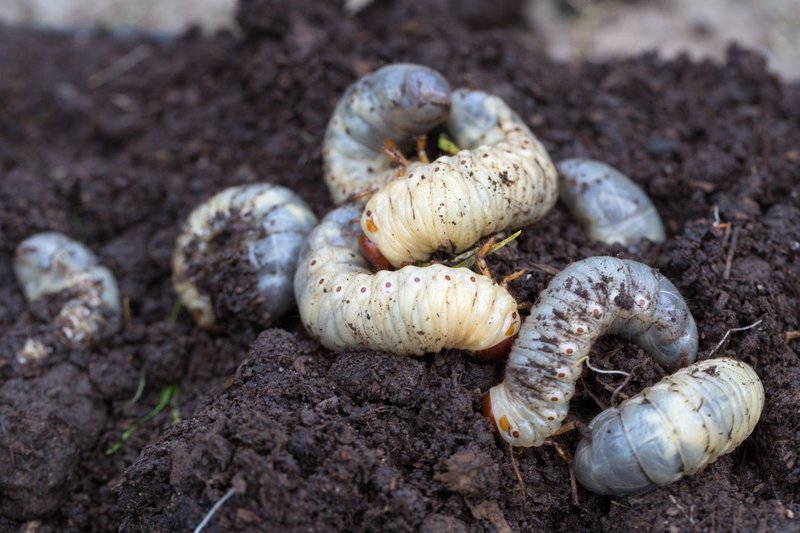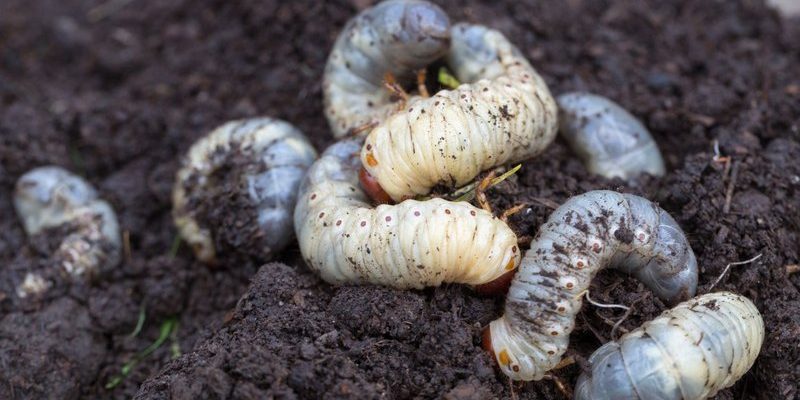
In dry spells, these little larvae tend to change their habits. Instead of hiding out in moist soil, they might venture closer to the surface in search of food, especially as the earth becomes harder and less hospitable for them. This behavior can lead to increased damage to your lawn and garden as they munch on delicate roots. Brands like GrubEx offer solutions for managing grub worms, but knowing when and how to act is crucial. So, let’s dive into the world of grub worms and see how drought influences their activity and what you can do to protect your green space.
What Are Grub Worms?
Grub worms are the larval stage of several types of beetles, most commonly the Japanese beetle. They’re usually white, C-shaped, and can be found lurking beneath the soil surface. These larvae feed on the roots of grass and plants, which can lead to significant damage if left unchecked. Imagine having tiny pests munching away at the base of your favorite flowers or your lush lawn—it’s not a pretty picture!
Their life cycle generally includes four stages: egg, larva (grub), pupa, and adult beetle. The larvae spend a good chunk of their time underground, feeding and growing. When conditions are right, especially in warm months, they’ll dig deeper into the soil, which is often the exact time people start noticing issues. In drought conditions, grub worms might behave differently than when there’s plenty of moisture, which impacts how we should approach their management.
How Drought Affects Grub Behavior
During a drought, the soil dries out, and the habitat that grub worms typically thrive in changes. With less moisture, they may not be able to stay where they are comfortable. It’s like trying to enjoy a nice picnic in a park during a drought; you wouldn’t want to stay there if things were too dry and miserable. As a result, grub worms might move closer to the surface, where they can find softer soil to navigate and more root systems to feast on.
You might be wondering, “Does this mean they’re more destructive during a drought?” The answer is yes, but it varies based on several factors. If your lawn is already under stress from the lack of water, it becomes more susceptible to grub damage. Essentially, a thirsty lawn is like an open buffet for these hungry little creatures. So, keeping your lawn well-hydrated is key to minimizing their impact.
Signs of Grub Worm Damage
Recognizing grub worm damage early can save you a lot of trouble down the line. If you notice patches of brown grass that don’t spring back when walked on, it’s possible that grubs are at work. Other signs include thinning grass and roots that easily pull away from the soil. Here’s what to look for:
- Brown patches: These may appear sporadically in your yard. If the grass is crunchy and dead, check for grubs underneath.
- Pull test: Try to pull a section of grass. If it comes up easily, the roots have likely been eaten by grubs.
- Presence of adult beetles: If you see beetles flying around your garden in the summer, they could have laid eggs that turn into grubs.
If you suspect grubs are lurking below the surface, a quick inspection can reveal if they’re the culprits. Keep an eye out especially during dry spells when they’re more active.
How to Manage Grub Worms During Drought
Managing grub worms effectively during drought conditions requires a strategic mix of prevention and treatment. Here are a few methods to get you started:
1. **Watering**: Deep, infrequent watering can help keep your lawn healthy without making it too hospitable for grubs. Think of it as giving your plants a refreshing drink without drowning them.
2. **Natural Predators**: Encourage birds, beneficial nematodes, and other natural predators in your yard. They can help keep grub populations in check.
3. **Pesticides**: If you find an overwhelming number of grubs, you may need to consider insecticides, especially those designed for grub control. Use products like GrubEx during the recommended application times to break the grub life cycle.
By implementing these strategies, you can help protect your garden from grub worm damage even when drought conditions are a factor.
Timing Is Everything
The timing of your interventions is important when dealing with grub worms, especially during drought. The best time to treat for grubs is typically in late summer or early fall when they’re most active and close to the surface. This timing will coincide with when many gardens and lawns are also struggling from the heat.
Applying preventative measures during this time can help keep your garden healthy. Think of it like preparing for winter: the better you prepare now, the less you’ll have to deal with unexpected problems later. If you wait until spring, you might be too late, as the damage could already be done.
Long-Term Strategies for Grub Worm Control
Looking at the bigger picture, there are several long-term strategies you can adopt for managing grub worms. Here are a few tips:
– **Soil Health:** Maintaining healthy, aerated soil can make a big difference. Healthy soil is often more resistant to pests and diseases.
– **Healthy Lawn Practices:** Fertilizing, overseeding, and encouraging diversity in your plants can create a resilient ecosystem that’s less appealing to grubs.
– **Monitoring:** Regularly check your lawn and garden for signs of infestation. Early detection is key to preventing damage.
By looking at both short-term interventions and long-term practices, you can create a garden that stands strong against not just grubs, but other pests too.
So there you have it! Grub worms can be a real nuisance, especially during drought conditions when they might change their behavior and become more visible. But with some knowledge about their habits, you can be proactive in protecting your garden. It’s all about understanding what’s happening beneath the surface and taking the right steps to safeguard your plants.
Remember, keeping your lawn healthy through proper watering and soil management is key to minimizing grub activity. With a little attention and care, you’ll be well on your way to a thriving garden—even in dry spells. Keep those plants happy, and you’ll enjoy a beautiful landscape!

